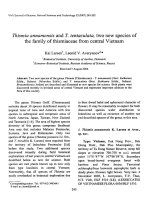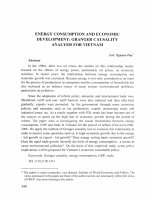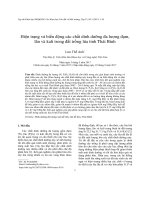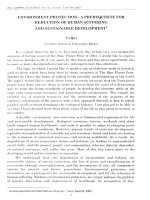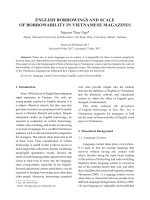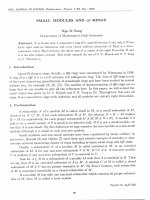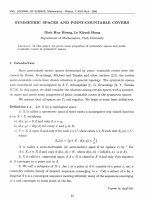DSpace at VNU: Culture comparison and culture change-case study of ABB VietNam and ABB Singapore
Bạn đang xem bản rút gọn của tài liệu. Xem và tải ngay bản đầy đủ của tài liệu tại đây (188.23 KB, 7 trang )
Culture comparison and culture change-case
study of ABB VietNam and ABB Singapore
Nguyễn Thị Hồng Liên
Khoa Quản trị Kinh doanh
Luận văn Thạc sĩ ngành: Quản trị Kinh doanh; Mã số: 60 34 05
Người hướng dẫn: TS. Đào Thị Thanh Lam, ThS. Hà Nguyên
Năm bảo vệ: 2012
Keywords. Quản trị kinh doanh; Văn hóa doanh nghiệp
Content
TABLE OF CONTENT
ACKNOWLEDEMENTS ....................................................................................................... i
ABSTRACT ........................................................................................................................... ii
TÓM TẮT............................................................................................................................. iv
TABLE OF CONTENT........................................................................................................ vi
LIST OF TABLES................................................................................................................ ix
LIST OF FIGURES ............................................................................................................... x
INTRODUCTION ................................................................................................................. 1
CHAPTER 1: LITERATURE REVIEW ............................................................................... 3
1.1.
Definitions................................................................................................................ 3
1.1.1.
Culture............................................................................................................... 3
1.1.2.
Organizational Culture ...................................................................................... 5
1.2.
Cultural layers &
1.2.1.
cultural diversity....................................................................... 6
The out layer (Explicit Products/Artifacts) ....................................................... 8
1.2.2.
The middle layer (Norms and Beliefs/Espoused Beliefs and Values) ............ 10
1.2.3.
The core (Basic Assumptions/Underlying Assumptions) ............................... 11
1.3.
Sub-culture ............................................................................................................. 15
1.4.
The importance of organizational culture .............................................................. 15
1.4.1.
Coordination ................................................................................................... 16
1.4.2.
Integration ....................................................................................................... 17
1.4.3.
Motivation ....................................................................................................... 18
1.4.4.
How well can organizational culture do its functions? ................................... 18
1.5.
Culture analysis -OCAI method............................................................................. 19
1.5.1.
General about culture analysis methods ......................................................... 19
1.5.2.
Advantages of OCAI method .......................................................................... 24
1.5.3.
Dimensions in OCAI ....................................................................................... 25
1.5.4.
Questionnaire applied in OCAI....................................................................... 27
1.5.5.
Scoring the OCAI............................................................................................ 28
1.5.6.
What can be found from OCAI result ............................................................. 28
1.6. Methodology applied in the thesis ............................................................................ 37
1.6.1.
OCAI method .................................................................................................. 37
1.6.2.
Interview method ............................................................................................ 37
1.6.3.
Other analysis methods ................................................................................... 38
1.6.4.
Focused points................................................................................................. 38
CHAPTER 2: CULTURE ANALYSIS IN ABBPP DIVISIONS ...................................... 39
2.1.
Introduction about ABB Singapore and ABB Vietnam ...................................... 39
2.1.1.
Introduction about ABB Group....................................................................... 39
2.1.2.
Introduction about ABB Vietnam (VNABB) and ABB Singapore (SGABB) .. 42
2.2.
Organizational culture comparison between SGABB’s and VNABB’s PP
Division ............................................................................................................................ 45
2.2.1.
Different dominant cultures but same major culture types ............................. 45
2.2.2.
The current dominant culture gains cultural congruencein both countries... 48
2.2.3.
Differences in expected dominant culture types ............................................. 53
2.2.4.
Less cultural congruence for the expected dominant cultures & the inevitable
emergence of Clan and Adhocracy .............................................................................. 54
2.2.5.
Diversity in expectation of employee groups ................................................. 58
2.3.
Factors influencing organizational cultures
2.3.1.
The vital role of standardization in ABB’s operation ..................................... 60
2.3.2.
Market situation and market orientation in ABB Group................................. 62
2.3.3.
Asian culture - a strong factor supporting for Clan Culture............................. 66
2.3.4.
Adhocracy Culture - an answer to the dilemmas ............................................. 66
2.3.5.
Business nature & the major sub-groups ......................................................... 66
in the twoDivisions ..................... 60
CHAPTER 3: RECOMMENDATIONS ............................................................................. 68
3.1.
The importance of defining culture profile .......................................................... 68
3.2.
Culture incongruence requires leadership involvement....................................... 68
3.2.1.
Leaders are to listen and respect the needs ofemployees ................................. 69
3.2.2.
Vision the future culture to pursuit .................................................................. 69
3.2.3.
Define the culture transformation process ....................................................... 70
3.3.
Visioning the transformation ............................................................................... 70
3.3.1.
ABB Vietnam - PP Division ............................................................................ 71
3.3.2.
ABB Singapore - PP Division .......................................................................... 75
3.4.
Operational change for the cultural change ......................................................... 79
3.4.1.
In ABB Vietnam - PP Division ........................................................................ 79
3.4.2.
In ABB Singapore - PP Division ..................................................................... 83
3.5.
International cooperation and global resource utilization.................................... 88
CONCLUSION .................................................................................................................... 91
REFERENCE ....................................................................................................................... 93
APPENDIX 1: VARIOUS CATEGORIES USED TO DESCRIBE CULTURE ............... 97
APPENDIX 2: ENVIRONMENTAL VARIABLES AFFECTING MANAGEMENT
FUCTIONS .......................................................................................................................... 99
APPENDIX 3: DENISON ORGANIZATIONAL CULTURE SURVEY........................ 100
APPENDIX 4: QUESTIONAIRE SAMPLE .................................................................... 101
APPENDIX 5: CULTURE PROFILE COMPARISION VIETNAM VS. SINGAPORE 105
References
BOOKS
1. Amann, Dissertation on “The impact of internationalization on organizational culture
a comparative study of international US and German companies”,
University of St.Gallen, German, 2003, pg.40
2. Cameron & Quinn, “Diagnosing and Changing Organizational Culture: based on the
competing values framework”, Jossey Bass, Revised Edition, 2006, pg.26-30, pg.37,
pg.40,
3. Deresky, “International Management - Managing Across Borders and Cultures”,
Prentice Hall, USA, 2006, p.484, pg86, pg84,
4. H.Schein, “Organizational Culture and Leadership”, Jossey Bass, Third Edition, 2004,
page.17, pg.26, pg.30
5. Summersemester, “Multicultural Management”, International Technology Transfer
Management, 2004, p.2.
6. Thompson & Martin, “Strategic management: awareness and change”, 5th edition,
Thomson Learning, pg.377
7. Trompenaars & Hampden-Turner, “Riding the waves of cultures - Understanding
cultural diversity in business”, Nicholas Brealey Publishing, London, 2nd edition,
1998, pg.5, pg.21, pg22, pg24
8. Vo, Hong Nga, Dotoral thesis. “Nexus between organizational cutlure and IT
implementation in Vietnamese organizations”, Swinburne Universtity of Technology,
pg.27
WEBSITE
9. Truman State University, Invitation to Cultural Evolutionism, Founding Figures,
Edward Tylor, />10. Cambridge Online Dictionary,
http://di cti onary. cambrid ge .org/di cti onary/briti sh/culture 1
11. Changingmind.org,
Explanation,
Culture
/>12. Definitions
of
Organizational
Culture
/>13. Brain Bacon, “Aligning People with Stratergy”, www.Oxfordleadership.com
14.
15. OCAI Online, />•
Culture change is difficult and why OCAI />
•
OCAI
helps
Ericsson
work
on
high
performance
i-
online.com/blog/2011/01/OCAI-Helps-Ericsson-Work-on-High-PerformanceCulture
•
The competing value frame work with 4 major clusters />
•
Competing Values Leadership: quadrant roles and personality: people sometimes
wonder how they personally fit into the current and preferred organizational
culture
types
/>
Leadership- quadrant-roles-and-personality
•
Interpret culture profile - Philadelphia Care - Is it good when we stay the same?
/>
•
An example about Clan culture in a Health Care Center />
•
Interpret
culture
profile
-
interesting
i-
online.com/blog/2010/05/Organizational-culture-in-Financial-organizations
•
Culture in large organizations: focus in productivity and less on people
/>
with-OCAI
•
Case
study
/>
Achieving-Stellar-Results
•
/>
•
Organizational
Culture
Types
/>
Organizational-Culture-Assessment-Instrument-OCAI/Organizational-CultureTypes
• />• OCAI Pro example report: Dutch public administration i-
online.com/userfiles/file/ocai pro example report.pdfb
• OCAI Online, OCAI Instrument General Introduction, i-
online.com/userfiles/file/ocai general information.ppt
16. Hofstede’s academic site />17. Hofstede and Schwartz’s models for classifying individualism at the cultural level:
their
relation
to
macro-social
and
macro-economic
variables
/>18. Helen Deresky’s website www.prehall .com/deresky
19. Academic Leadership The Online Journal, “The impact of national cultures on
corporate cultures in organisations ”, />20. Academy of Management Executive, 2004, Vol. 18, No. 1, “Hofstede’s
consequences: The impact of his work on consulting and business practices”,
cons.pdf
21. Elke Duncker, Paul Curzon, “Cross-Culture interface Design Strategy”, Middlesex
University, 2004, aHR0cDovL2NpdGVzZWVyeC5pc3QucHN1LmVkdS92aWV3ZG9jL2Rvd
25sb2FkP2RvaT0xMC4xLiEuQTkuNDYzNSZyZXA9cmVwMSZ0eXBlPXBkZg==
22. Kyoto Univesity, Research Institute for Mathematical Sciences, “A Study of the
Relationship between Organizational Culture and Organizational Effectiveness of the
Electronic Industries in Taiwan”, />23. Daniel R. Denison, “Organizational Culture and Organizational Effectiveness: A
Theory and Some Preliminary Empirical Evidence ”, School of Business
Administration, University of Michigan,
cult eff.pdf
“Effects
24. Organizationalculture101.com,
Of
Organizational
Culture”,
/>25. Léo F. C. Bruno, Ph.D, “The Impact of Organizational Culture on Innovation
Management”,
E-Leaders,
Conference,
http://www.g-
casa.com/conferences/budapest/papers/Bruno.pdf
26. Prof. Dr. Peter Gomez , “The impact of internationalization on organizational culture - A
comparative study of international US and German companies”, University of St.Gallen,
/>27. Francis D. Tuggle, Ph.D. and Nancy C. Shaw, Ph.D., “The Effect of Organizational
Culture on the Implementation of Knowledge Management”, Association for the
Advancement
of
Artificial
Intelligence,
/>28. Cynthia Webster, “Exploring The Relationships Among Organizational Culture,
Customer
Satisfaction,
And
Performance”,
Mississippi
State
University,
/>29. www.sagepub.com, “Organizational Culture and Performance”,
epub. com/upm-data/9432 010384ch3.pdf
30. Social Science Research Network, “The Influence Of Organizational Cultural
Dimensions
On
The
Financial
Performance
/>
Of
Selected
Nepali
Banks”,
id=1624690&
.vn/search?hl=vi&biw=1260&bih=618&q=the+influence+organizational+culture+fina
ncial+performance&aq=f&aqi=&aql=&oq=
31. Mahmood Karim, “Relationship between Corporate Culture and Organizational
Effectivenss: A Case Study on Zain Telecommunication Limited, Social Science
Research Network”,
/>
id=1624690&
.vn/search?hl=vi&biw=1260&bih=618&q=the+influence+organizational+culture+fina
ncial+performance&aq=f&aqi=&aql=&oq=
32. Classifying
of
Organizational
Culture
culture
